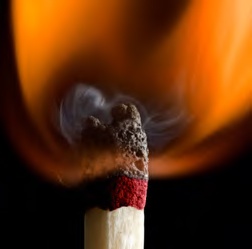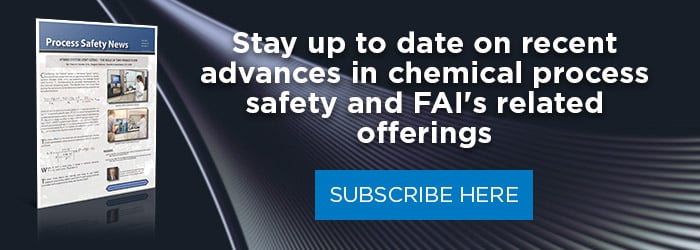By Rick Kwasny, Ph.D., Senior Consulting Engineer, Fauske & Associates
One of the major hazards in chemical industries is a fire. Fire in the process industries is the most reported hazard and causes a significant amount of deaths, injuries, and damage.
 Fires could also lead into or be a result of other major hazards (e.g. explosions or toxic release). Therefore, it is important we understand the flammability characteristics of flammable materials to avoid unwanted fires and explosions. One strategy that can be employed to analyze the hazards is a flammability hazard assessment.
Fires could also lead into or be a result of other major hazards (e.g. explosions or toxic release). Therefore, it is important we understand the flammability characteristics of flammable materials to avoid unwanted fires and explosions. One strategy that can be employed to analyze the hazards is a flammability hazard assessment.
A flammability hazard assessment can involve the following scenarios but is not limited to:
- In part, due to an OSHA PSM audit
- Management of change involving flammable materials
- Review previous incident(s) involving fire or explosion to ensure causative and preventative actions are identified and implemented
- Review of preliminary or detailed engineering design
- When considering the use of an oxidizer, e.g., oxygen, in a batch reaction involving a flammable liquid, safeguards must be developed to allow working safely with an oxygen-enriched headspace
- Objectively assess the flammability safety status of a legacy facility
- To better understand issues related to an OSHA citation
Depending upon the scope and complexity of the issues, the following methodologies can be used:
- On-site hazard assessment: A comprehensive review to identify potential hazards and recommend practical safeguards
- On-site walkthrough: A focused review to provide an overview of current safeguards used in flammable service
- Desktop review: There is no on-site component. The engineer would review process information drawings, operating procedures, and other documentation to assess the adequacy of the current facility operations with respect to the safe processing of flammables
- Flammability testing: There are many test results available in the open literature. However, if the temperature, pressure, or impurity profile falls outside the usual range, it can be necessary to recommend testing of specific plant samples at specified conditions.
It is best to work with one of our consulting engineers to determine the type of assessment to be used and the advantages of each.
In order to allow the client and our engineer to be on the same page the following information needs to be reviewed prior to the assessment:
- Determine if a Non-Disclosure Agreement (NDA) will be needed to allow for the free exchange of the issues involved
- A document summarizing the unit operations involved in the process(s)
- A basic Process Flow Diagram to illustrate the process flow logic of the unit operations from the beginning to the final product including all waste streams
- The names and quantities of the materials of the process including their flammability hazards
- State the expectations or outcomes anticipated at the end of the project
- Identify any future plans that could impact on this project
The engineer will develop an agenda based on discussions with the client to ensure that all facilities, processes, equipment, and waste handling streams will be assessed.
Other items that need to be reviewed are:
- Bonding and grounding to safely dissipate static charges and avoid unwanted static accumulation, which can be an ignition source
- Control of ignition sources
- Inerting procedures and verification of adequacy
- Equipment inspection and preventative maintenance to proactively avoid unwanted breakdowns
- The order of protective systems should be engineering controls, administrative controls, and personal protective equipment. Flammability and oxygen sensors with alarms and equipment interlocks should be used first, followed by manual controls to adjust the process, and adequate PPE to protect affected personnel
- Firefighting measures, such as sprinklers, fire extinguishers, chemical foam systems, etc. Firefighting response (in-house brigade and mutual aid), which should be part of the Emergency Response Plan
- Hot Work Permit systems to ensure potential ignition points are controlled during maintenance procedures
- LockOut/TagOut program to ensure deenergization of affected equipment during Hot Work or maintenance operations
- Flammability training packages for affected employees. This is an important issue since Operators are often involved in making decisions on how to respond to a flammability issue, and the first efforts can often result in significant situations.
Safety Reviews:
There are a number of in-house reviews that can be conducted involving flammable materials:
- Preliminary engineering design
- Detailed engineering design
- Pre-startup safety review
- Process Hazard Analysis
If management has determined, there is a need for a flammability subject matter expert, Fauske & Associates, has often been involved with the client’s team.
Next Steps:
If you have or believe you have a flammability issue, do not hesitate to contact us regarding your concerns at oss@fauske.com. We will then work with you to develop an appropriate response based on your needs.
References
- NFPA 30, “Flammable and Combustible Liquids Code,”
- NFPA 33 Codes 7.11, “Paint Booth Technologies,”
- NFPA 68, “ Standard on Explosion Protection by Deflagration Venting,”
- NFPA 69, “Standard on Explosion Prevention Systems,”
- NFPA 70, “National Electric Code”,
- NFPA 72, “National Alarm and Signaling Code,”
- NFPA 77, “Recommended Practice on Static Electricity,”
- NFPA 497, “Recomm ended Practice for the Classification of Flammable Liquids, Gases, or Vapor and of Hazardous (Classified) Locations for Electrical Installations in Chemical Process Areas,”
- Britton G., Laurence, “Avoiding Static Ignition Hazards in Chemical Operations,” American Institute of Chemical Engineers, CCPS Concept Book, 1999,
- Brodurtha, F. T., “Industrial Explosion Prevention and Protection,”
- 1OS HA 29 CFR 1910.120 “Hazard Communication Standard ,”
- OS HA 29 CFR 1910.106; Flammable and Combustible Liquids,
- Lees, P. F., “Loss Prevention in the Process Industries,” Volume 1
#on site services

